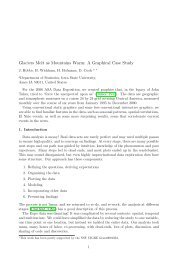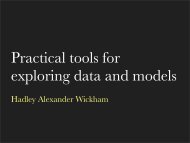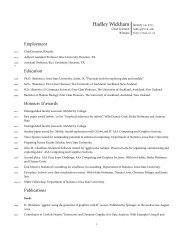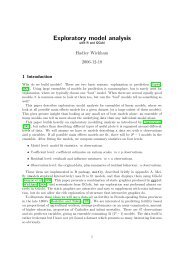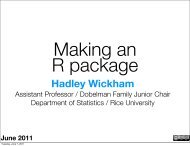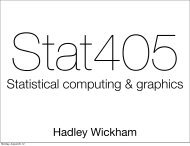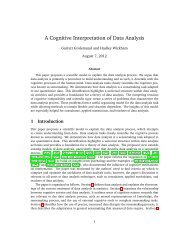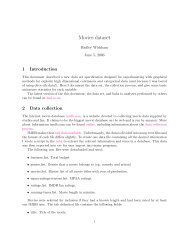You also want an ePaper? Increase the reach of your titles
YUMPU automatically turns print PDFs into web optimized ePapers that Google loves.
July 2010<br />
Friday, 9 July 2010<br />
<strong>Data</strong> <strong>cleaning</strong><br />
<strong>Hadley</strong> <strong>Wickham</strong><br />
Assistant Professor / Dobelman Family Junior Chair<br />
Department of Statistics / Rice University
Friday, 9 July 2010<br />
1. Intro to data <strong>cleaning</strong><br />
2. What you can fix<br />
3. What you can’t fix
Friday, 9 July 2010<br />
<strong>Data</strong><br />
<strong>cleaning</strong>
“Happy families are all alike;<br />
every unhappy family is<br />
unhappy in its own way.”<br />
—Leo Tolstoy<br />
Friday, 9 July 2010
“Clean datasets are all alike;<br />
every messy dataset is<br />
messy in its own way.”<br />
—<strong>Hadley</strong> <strong>Wickham</strong><br />
Friday, 9 July 2010
Friday, 9 July 2010<br />
No magic bullet<br />
No sequence of steps that will work in<br />
every case.<br />
Often will need to clean the data<br />
repeatedly, as you discover new problems<br />
during the analysis process.<br />
You know the basic tools - I’ll show you<br />
some new ways of applying them.
Friday, 9 July 2010<br />
What you<br />
can fix:
Friday, 9 July 2010<br />
Rectangular
Friday, 9 July 2010<br />
Observations<br />
in rows
Friday, 9 July 2010<br />
Variables<br />
in columns
Friday, 9 July 2010
Friday, 9 July 2010
library(reshape)<br />
library(stringr)<br />
options(stringsAsFactors = FALSE)<br />
note_raw
Friday, 9 July 2010<br />
Your turn<br />
What are the variables in<br />
country_population.csv and<br />
tb_notification.csv? How are they<br />
arranged in rows and columns? Can you<br />
form the variables into two groups?<br />
(Hint: you might need to look at the data<br />
dictionary)
Friday, 9 July 2010<br />
Identifier variable Measured variable<br />
Index of random<br />
variable<br />
Random variable<br />
Dimension Measure<br />
Experimental design Measurement<br />
Key Value
Friday, 9 July 2010<br />
Molten data<br />
Molten data has all variables in the<br />
rows, and all measured variables<br />
the columns. Sometimes called<br />
“long” form.<br />
Easy to pour into new shapes,<br />
graphics and models<br />
reshape::melt(data, measure, id)
Friday, 9 July 2010<br />
Your turn<br />
Melt the data. What are the id variables<br />
present in this data? What are the<br />
measured variables?
note
Pregnant<br />
Not-<br />
pregnant<br />
Friday, 9 July 2010<br />
Implicit vs. explicit<br />
missings<br />
Male Female<br />
10<br />
20 15<br />
Sex Pregnant Count<br />
Male No 20<br />
Female Yes 10<br />
Female No 15
Friday, 9 July 2010<br />
Your turn<br />
What’s missing? How does this data set<br />
compare to our original list of variables?<br />
Think about the operations you’d need to<br />
perform to create any extra pieces.
note$variable
# Combine into one file<br />
rate
# Why this form?<br />
# Because it works well with all our existing tools<br />
# Easy to summarise<br />
totals
Friday, 9 July 2010<br />
Concise<br />
(each fact represented once)<br />
Consistent<br />
(if repeated, each fact is the same)
Friday, 9 July 2010<br />
TB<br />
This data is already very concise, and<br />
therefor it’s also consistent.<br />
Did you spot the exception?
note_total
Friday, 9 July 2010<br />
Whenever there is inconsistency, you are<br />
going to have to make some tradeoff to<br />
ensure concision.<br />
In general<br />
Detecting inconsistency is not always<br />
easy, but you now have the basic tools.
Friday, 9 July 2010<br />
What you<br />
can’t fix:
Friday, 9 July 2010<br />
Complete<br />
Correct
Friday, 9 July 2010<br />
Correct<br />
Can’t restore correct values without<br />
original data but can remove clearly<br />
incorrect values<br />
Options:<br />
Remove entire row<br />
Mark incorrect value as missing
Friday, 9 July 2010<br />
What is a missing<br />
value?<br />
In R, written as NA. Has special<br />
behaviour:<br />
NA + 3 = ?<br />
NA > 2 = ?<br />
mean(c(2, 7, 10, NA)) = ?<br />
NA == NA ?<br />
Use is.na() to see if a value is NA<br />
Many functions have na.rm argument
Friday, 9 July 2010<br />
General strategy<br />
To find incorrect values you need to be<br />
creative, combining graphics and data<br />
processing.<br />
I’m going to try and give you a flavour of<br />
this process with another data set.
Friday, 9 July 2010<br />
Diamonds data<br />
~54,000 round diamonds from<br />
http://www.diamondse.info/<br />
Carat, colour, clarity, cut<br />
Total depth, table, depth,<br />
width, height<br />
Price
Friday, 9 July 2010<br />
x<br />
table width<br />
depth = z / diameter<br />
table = table width / x * 100<br />
z
Friday, 9 July 2010<br />
Your turn<br />
Look at histograms and scatterplots of x,<br />
y, z from the diamonds dataset (it’s<br />
included in ggplot2)<br />
Which values are clearly incorrect? Which<br />
values might we be able to correct?
Friday, 9 July 2010<br />
Plots<br />
qplot(x, data = diamonds, binwidth = 0.1)<br />
qplot(y, data = diamonds, binwidth = 0.1)<br />
qplot(z, data = diamonds, binwidth = 0.1)<br />
qplot(x, y, data = diamonds)<br />
qplot(x, z, data = diamonds)<br />
qplot(y, z, data = diamonds)
y_big 10<br />
z_big 6<br />
x_zero
Friday, 9 July 2010<br />
Your turn<br />
Fix the incorrect values and replot<br />
scatterplots of x, y, and z. Are all the<br />
unusual values gone?
diamonds$x[x_zero]
Friday, 9 July 2010<br />
New variables<br />
When <strong>cleaning</strong>, derived variables will be<br />
very important.<br />
e.g. qplot(a, b) is a straight line, then<br />
qplot(a, a / b) will be a flat line.<br />
For this example, we can also approximate<br />
the volume of a diamond, and use what<br />
we know about the density of diamonds.
Friday, 9 July 2010<br />
Your turn<br />
Using what you know about the density of<br />
diamonds, clean this data up some more.
diamonds
diamonds
ad 0.007)<br />
qplot(density, data = diamonds[!bad, ])<br />
subset(diamonds, bad)<br />
qplot(carat, density, data = diamonds[!bad, ])<br />
qplot(y, x/y, data = diamonds[!bad, ])<br />
Friday, 9 July 2010
Friday, 9 July 2010<br />
Summary
Friday, 9 July 2010<br />
Clean data is:<br />
Rectangular<br />
(observations in rows, variables in columns)<br />
Consistent<br />
Concise<br />
Complete<br />
Correct
Friday, 9 July 2010
This work is licensed under the Creative<br />
Commons Attribution-Noncommercial 3.0 United<br />
States License. To view a copy of this license,<br />
visit http://creativecommons.org/licenses/by-nc/<br />
3.0/us/ or send a letter to Creative Commons,<br />
171 Second Street, Suite 300, San Francisco,<br />
California, 94105, USA.<br />
Friday, 9 July 2010



